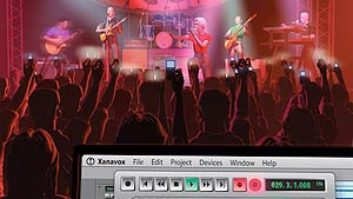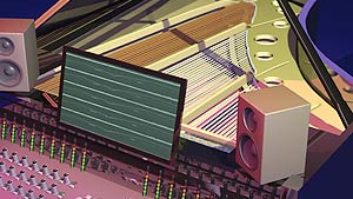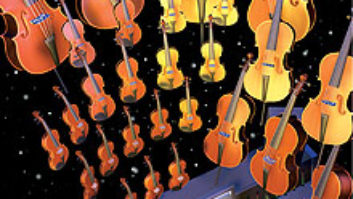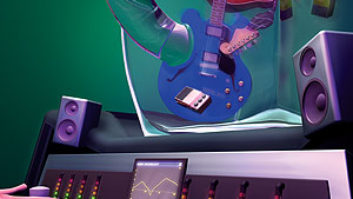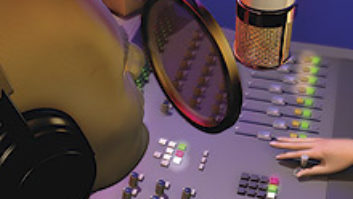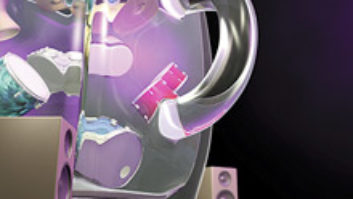

This feature marks the first installment of
Mix‘s six-part “Recording the Band” Series by technical editor Kevin Becka. In these bi-monthly articles, Becka explores recording the band in-depth — from piano to guitars, from tracking to effects — with innovative new tips and advice from the pros on making the most of your recordings. This month, in “Percussive Perfection,” Becka shares insights on all of the steps for capturing a great kit sound — from instrument prep to the final mix.
Recording drums is arguably one of the most daunting tasks an engineer encounters in the studio. This is because you’re not just recording one instrument, but a group of percussive instruments played as a unit. It’s not only important that each member of the drum “family” speaks well on its own, but that the kit is played and sounds good as a whole, not just as individuals. The whole approach begins with the drums and the room, and is dramatically affected by each variable along the way, from the player to mic choices, signal chain, recording medium and mixing approach. Any weak link in this chain will alter your outcome, so it’s important to choose your moves wisely to get an ideal drum sound.
IT’S ALL ABOUT THE INSTRUMENT
Pro studio drummers will bring a wide variety of drums to a session, even changing kits or parts of a kit from song to song. As a rule, drums that are deeper than they are wide at the rim will have more ring to them, whereas “fat” drums, equal or closer in width/depth ratio, will have more tone and a shorter decay. For example, Led Zeppelin’s John Bonham used a 14×26-inch kick drum to get his signature huge sound.
Outside of high-end sessions, drums are often given the short end of tuning and preparation. Not only are there issues with tuning individual drums, top and bottom, and tuning the kit as a cohesive whole, but there are countless other clicks, pops and squeaks that can turn a kit into an industrial-sounding nightmare. The time spent getting the kit to sound right before the session will pay off in a great-sounding foundation track. Be sure to read the drum tuning tutorial on page 30.
YOUR SPACE EQUALS YOUR SOUND
An ideal recording space is as important as preparing and tuning your kit. A room that is too dead is not necessarily a bad thing, nor is a small room. (See “Case Study” sidebar at right.) However, a room that is too live or boxy-sounding with nasty standing waves can play havoc with your recording. On the other hand, just because a room is well-designed doesn’t mean that drums will sound good wherever you place them. Rooms have sweet spots for different instrument groups. There are no hard and fast rules, but building on the experiences of others can save you a lot of headaches, especially when time is tight and you don’t have the budget for experimentation. Talking to someone who has recorded in the room can provide a lot of useful information.
MIKE IT UP
There are various drum miking techniques that engineers have successfully used during the years. For snare and toms, go-to mics — typically dynamics such as the Audio-Technica ATM25 or Sennheiser e504 — placed just over the edge of the drum, two fingers off the rim and pointing to the center of the head usually works well. For kick, the combination of a mic inside and outside of the drum, capturing the attack and resonance of the respective beater and front heads then mixed to taste, has put the thump in many a hit record. (For a video demonstration of these techniques and more, visit our interactive Seminar on Demand: Drum Recording Techniques at www.mixonline.com.) It’s the offbeat ideas, though, that provide food for thought when hunting for your next favorite sound.
The kick drum lends itself to various unique techniques and gear. For instance, Yamaha’s new Subkick takes an old trick — using a speaker as a microphone — and gives it a new look. The Subkick is a 6.5-inch speaker mounted in a 10-inch drum shell. Because of the inefficiency of the speaker, it rolls off starting at 100 Hz. This technique works best when the Subkick is combined with another mic placed inside the drum to capture the attack of the beater. Producer Michael Wagener (see sidebar on page 31) uses a homemade version of this device, built with a 5-inch speaker mounted in an aluminum frame. He uses the speaker on the outer head and places a Shure SM91 on the inside of the drum. To further dial in some thump, he phase-aligns the two mics using LittleLabs’ IBP (In-Between Phase tool).
One of the more interesting (and dangerous) kick miking techniques involves very precise placement of a high-SPL mic (such as the DPA 4007) quite close to the inside head. To keep the drum from scooting closer to the mic as the kit is played, the mic should not be mounted on a traditional stand, but instead clamped to the hardware that supports the rack tom. Then, while the drummer is playing, let the head — just to the left or right of the beater — touch the back of your pinky finger as a calibrator. (A pop filter will keep the wind from a drum diaphragm from overloading the mic capsule.) This placement offers a lot of 500Hz cut and an infrasonic harmonic down to about 20 Hz. A variety of tones can be had by mixing this mic with a traditionally placed AKG D112, Sennheiser 421 or beyerdynamic M88. Also, try reversing polarity between the two mics.
The new Holophone surround mic can be used in both stereo and surround applications.
MINIMALIST METHODS
Two interesting and very simple techniques employ three microphones to record the entire kit. One technique uses a single Neumann U87 set to omni as an overhead, a D112 on the kick and a Shure SM56 on the snare. The second minimalist setup is using three omnis in a down-firing Decca Tree directly over the kit, creating an equilateral triangle of three omni-pattern overhead mics with the kit in the center. This setup can be useful to capture a drummer who is not only playing the full kit but an array of percussive toys across the stereo field.
Another simple technique that can be added to a traditional miking setup calls for using two omnis placed strategically under the cymbals. This captures some of the tone that is lost when mics are placed just above the cymbals. Placement is basically between tom 1 and the hi-hat on the one side, and the matching spot on the other side of the kit between rack tom 2 and the floor tom. The kick drum develops nicely between the two mics, and a spot mic on the kick can bring it out even more.
MULTICHANNEL TECHNIQUES
An interesting multichannel technique comes from engineer Gary Baldassari: In addition to miking drums in the traditional way, he places four DPA omni microphones in a Grado Vectored Array, which is an equidistant “box” of mics placed around the drummer with the mics either facing the drummer or away from the drummer, and either inches off the floor or high up in the room — determined by the room size, the style of music, the drummer and the kit. In addition to being an interesting surround technique that gives a very real picture of the drums in the room, the array will also collapse to mono or stereo. I recently tried this using four DPA 4061 mini microphones placed in a 12-foot square around a drum kit about chest-high on the drummer. For control room playback, I used the quad bus of an SSL 4000G+ console and rear speakers on stands. The technique rendered a very accurate picture of the kit as you’d hear it if you were in the room.
I recently recorded with the new Holophone H2 Pro 7.1 surround microphone, which incorporates eight DPA 4060 omni capsules in an enclosure looking like a cross between a soccer ball and football. In addition to this mic’s intended surround use, I also mused that it might be interesting if used in a stereo application. I placed the front of the mic facing downward over the drums, much like an overhead (see image below), and took the five capsules — L, C, R, Ls and Rs — to tape. To make this work in stereo, I panned the L, C and R to left, center and right, respectively, and used the Ls and Rs as I would room mics. This worked very well and mixed beautifully with the rest of the kit, which was miked in the traditional way. You can hear the results of these two recordings by downloading the short audio clips from the “Online Extras” area at www.mixonline.com.
AFTER THE SESSION
What you do after the drummer leaves can be the icing on the cake — or a nail in the audio coffin. Techniques vary, but a lot of engineers stay away from adding EQ to a track if possible, trying to get it right when tracking. The EQ-related phase shift associated with “fixing it in the mix” can destroy any kind of natural vibe that you captured in the session. When EQ is a must, it is invariably a subjective decision depending on the kit’s sound, musical style and other variables, so we won’t go into that here. There are, however, some other tricks you can use to create the best possible sound in the final mix.
It’s a speaker, it’s a mic: the Yamaha Subkick
One technique to optimize drum tracks is making room in the mix by cleaning up leakage on the kick and snare tracks. This method makes for less competition between the overheads and leakage in the kick and snare, which are usually ridden high in the mix. Expander/gates and DAW utility programs, such as Digidesign’s Strip Silence, can be used effectively here. In addition to clearing valuable mix space, this process also cleans up a snare track before you send it to a reverb, making for a pristine ambient tail that will sit nicely in the mix.
Riding the toms in a mix can also make more room during the body of the track. Rather than leaving the tom tracks up during the entire track, a group of tom faders can be left down in the mix and then raised naturally only as they play. Bringing them up as a group keeps the stereo image more centered than it would be if you gated them or rode them as individuals. Once the toms “speak,” you can bring them down again, making room for other tracks that are competing for the same space.
MAKING IT BIGGER
Using reverb to make drums sound larger than life is not a new concept, but it needn’t only be on an individual basis. For instance, if a bigger room sound is needed, then sending the room mics to a reverb’s ambient program and then mixing the 100-percent wet return back into the mix can significantly boost a kit’s ambient signature. When seeking a more organic sound, natural room ambience can be accentuated by using compression. A single mic placed above and behind the drummer, focused down at the kit and then crushed with a compressor, can make for an interesting ambience track, even in a small- to medium-sized room. This can be added to the track as a static part of the mix or during certain sections as a scene change.
Even something as simple as panning can focus a drum track or give the listener a different perspective on an instrument. Going old school and keeping the drums mono can make a lot of room for other instruments in a busy mix while keeping the pulse of the song centered and strong. Or, a completely unorthodox approach can sometimes work to give each player in the band his/her own space. For instance, on the Bad Plus’ CD Give, recorded and mixed by Tchad Blake, the piano is panned left, the bass right and the drums in the center. This serves up the trio in a completely fresh way, letting the listener hear each instrument in its own space.
IN THE END
No matter if you use any of the techniques here or the basic methods outlined in our online Seminar on Demand, the bottom line is that tone is king: The drums have to sound good before the Record button is pushed. Picking the right drum sizes, fitting them with new heads and then tuning them using the techniques outlined here will go a long way in making the kit sound right.
Next, work with your recording space — place the kit in the room where others have had success or blaze your own trail based on your own experience. After that, it’s a matter of finding the signal path, mics and miking techniques that convey what’s going on in the room.
Lastly, dressing up your material by making room in the mix, adding EQ if necessary and shaping the sound with compressors and added ambience will put the expert finishing touch on your recording.
Kevin Becka would like to thank Gary Baldassari, Tony Morra, David Rideau and Michael Wagener for their help in researching this feature.
CASE STUDY
TONY MORRA’S GREAT TRACKS FROM A SMALL ROOM
Nashville studio drummer Tony Morra (www.downtownbatterie.com) is a chameleon of sorts: Gigs on top pop, country and Christian albums with artists ranging from Jennifer Paige to Rachel Farris to Steve B, as well as his contributions to the Heavy Mental Discrete Drums library require him to deliver clean, tight drum tracks that are appropriate for any mix. In addition to playing in some of the top studios in Music City, Morra also has a list of e-clients who send him their tracks so he can lay down drums in his 20×22×8.5-foot home studio. Getting a big, clean sound out of this small space is the result of a combination of careful room design, kit choice and placement, and a finely honed recording technique that involves particular mic placement and signal chain choices.
To get the most from his modest space, Morra hired designer Dennis Kurtilla, who helped him with some simple and inexpensive ideas to convert his garage into an ideal drum tracking room, with variable acoustics to boot. After the room was done, Morra developed his recording techniques through experimentation, observation and brainstorming with Nashville engineer Steve Marcantonio. You can download a drum recording done at Morra’s studio and learn about his complete mic setup and recording chain at www.mixonline.com.
— Kevin Becka
INSTRUMENT PREP
TWEAKING AND TUNING THE KIT
Getting it right at the source is the first consideration when recording drums or any other instrument in the band. This should start with a general checkup of the hardware. Do any of the moving parts in the kick and hi-hat pedals have squeaks? WD-40 or Tri-Flow Teflon lubricant goes a long way in fixing this problem. Are there any buzzes or other noises that are undesirable? Track them down and fix them. Once you tighten up mechanical problems, you can concentrate on the heads and tuning.
New heads, like new guitar strings, will have more pronounced overtones, play better and stay in tune better. The first step in tuning a new head is to equally tighten all of the lugs on the top and bottom a bit further than you want them to be. Tighten the lugs in a star pattern across points, not like numbers on a clock. Once tightened, seat the head on the shell by pressing it down from the center of the head. Let the head settle a bit, tune them down a bit and up to where you want them to be.
When the head is close to the desired pitch, very lightly rest the meaty part of your thumb dead-center on the head with the same pressure you’d use when playing harmonics on a guitar or violin string. Tap a stick about an inch away from each tension rod. This technique allows you to better hear the pitch of the head near the tension rod so that each one can be matched to the other. In general, for tom tuning, you will have better results if the top and bottom heads are close to or perfectly in pitch with each other.
Once the heads are tuned, you can make small changes depending on the tone and effect that you want. For instance, if you want the pitch to travel down after the attack, detune the bottom head a bit; for a shorter decay, tune the bottom head higher than the top. This is a more desirable way to shorten decay than taping or using gels, which can affect the attack and tone. (A little goes a long way when pitching up a bottom head; a head that is too tight can result in a nasty buzz after the attack.) Snare heads can be further away in pitch. Tightening the bottom head will result in less-sympathetic snare chatter; the top head can then be tuned lower to taste. For a more “floppy” snare sound, the lugs nearest the snares on the bottom can be detuned.
For the kick, keep the batter head loose and get just enough tension on the front head to get some tone. A simple muting system is using a feather (not foam) pillow inside the drum. For a more open and boomy sound, a la John Bonham, omit the pillow and tune the resonant side and beater side to the same pitch.
— Kevin Becka
THE STORY BEHIND THE SOUND
MICHAEL WAGENER, SKID ROW AND A REALLY BIG TRACKING ROOM
Producer Michael Wagener recorded Skid Row’s self-titled debut album in 1988 at Royal Recorders in the resort town of Lake Geneva, Wis. Wagener was looking for a room with a big drum sound and was referred to the studio by producer Roy Thomas Baker. The studio was housed in the Playboy resort on the lake, next door to a convention center. The convention center was large enough to hold 120 cars; in fact, the day before they started recording, there was a car auction held in the building. Most of the drum reverb heard on the record is from that room.
Wagener miked the drums using a Shure SM57 above and below the snare and Sennheiser 421s on the toms. The kick had a full front head without a hole, so Wagener used a Countryman lavalier omni mic put through the airhole and suspended — taped to a pencil for stability — inside the drum. Wagener generally uses as little EQ as possible, but in this case, he added a bit of 60 Hz to round out the bottom of the kick tone. AKG C-12s were used for overheads with an older-model Schoeps mic on the ride cymbal. The hi-hat was recorded using an AKG 451E. Ironically, the mic that added the most ambience to the drum tracks was a heavily compressed SM57 meant for talkback and brought back through the Listen Mic section of an SSL 4000 Series console.
Wagener used a combination of John Hardy M1 mic preamps and the SSL’s preamps. The rest of the band was in the control room and had visual communication through a two-way video system.
— Kevin Becka

Click here to download .WAV files of a Grado Vectored Array recording, a Holophone recording and a clip of Tony Morra’s drum sound, and hear an MP3 clip from Skid Row’s self-titled debut, as featured in our sidebar, “Michael Wagener, Skid Row and a Really Big Tracking Room.”
Evans Drumheads’ Website has some useful information for tuning lugs on drum heads. Read more here
Now that you know all about recording a drum kit, click here to read Blair Jackson’s feature on recording percussion.
Michael Cooper interviews engineers David Bianco, Ed Seay and David Thoener, who share their drum miking techniques, here
.

